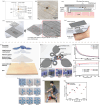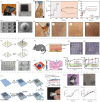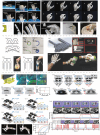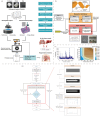3D-Printed Polymeric Biomaterials for Health Applications
- PMID: 39498750
- PMCID: PMC11694096
- DOI: 10.1002/adhm.202402571
3D-Printed Polymeric Biomaterials for Health Applications
Abstract
3D printing, also known as additive manufacturing, holds immense potential for rapid prototyping and customized production of functional health-related devices. With advancements in polymer chemistry and biomedical engineering, polymeric biomaterials have become integral to 3D-printed biomedical applications. However, there still exists a bottleneck in the compatibility of polymeric biomaterials with different 3D printing methods, as well as intrinsic challenges such as limited printing resolution and rates. Therefore, this review aims to introduce the current state-of-the-art in 3D-printed functional polymeric health-related devices. It begins with an overview of the landscape of 3D printing techniques, followed by an examination of commonly used polymeric biomaterials. Subsequently, examples of 3D-printed biomedical devices are provided and classified into categories such as biosensors, bioactuators, soft robotics, energy storage systems, self-powered devices, and data science in bioplotting. The emphasis is on exploring the current capabilities of 3D printing in manufacturing polymeric biomaterials into desired geometries that facilitate device functionality and studying the reasons for material choice. Finally, an outlook with challenges and possible improvements in the near future is presented, projecting the contribution of general 3D printing and polymeric biomaterials in the field of healthcare.
Keywords: advanced manufacturing; biomedical; healthcare; pharmaceutical; regenerative medicine.
© 2024 The Author(s). Advanced Healthcare Materials published by Wiley‐VCH GmbH.
Conflict of interest statement
The authors declare no conflict of interest.
Figures












References
Publication types
MeSH terms
Substances
Grants and funding
- R56EB034702/National Institutes of Technology
- CISE-IIS-2225698/National Science Foundation
- 2145895/NSF Faculty Early Career Development Program
- R56 EB034702/EB/NIBIB NIH HHS/United States
- R21 HL168656/HL/NHLBI NIH HHS/United States
- CBET-EBMS-1936105/National Science Foundation
- R21EB030257/National Institutes of Technology
- R01 CA282451/CA/NCI NIH HHS/United States
- Mayo Clinic and Arizona State University Alliance for Health Care Collaborative Research Seed Grant
- R01CA282451/National Institutes of Technology
- NPRP14S-0317-210064/Qatar National Research Fund
- RFGA2022-010-07/Arizona Biomedical Research Centre
- Brigham Research Institute
- R01HL153857/National Institutes of Technology
- R21 EB030257/EB/NIBIB NIH HHS/United States
- 2022-316712/Chan Zuckerberg Initiative
- R01GM134036/National Institutes of Technology
- R01 GM134036/GM/NIGMS NIH HHS/United States
- NSF Graduate Research Fellowships Program
- R01 HL166522/HL/NHLBI NIH HHS/United States
- R21HL168656/National Institutes of Technology
- ASU Women and Philanthropy Foundation
- R01HL166522/National Institutes of Technology
- GRFP 1000375560/National Science Foundation Graduate Research Fellowship Program
- R01HL165176/National Institutes of Technology
- R01 HL153857/HL/NHLBI NIH HHS/United States
- R01 HL165176/HL/NHLBI NIH HHS/United States
LinkOut - more resources
Full Text Sources

